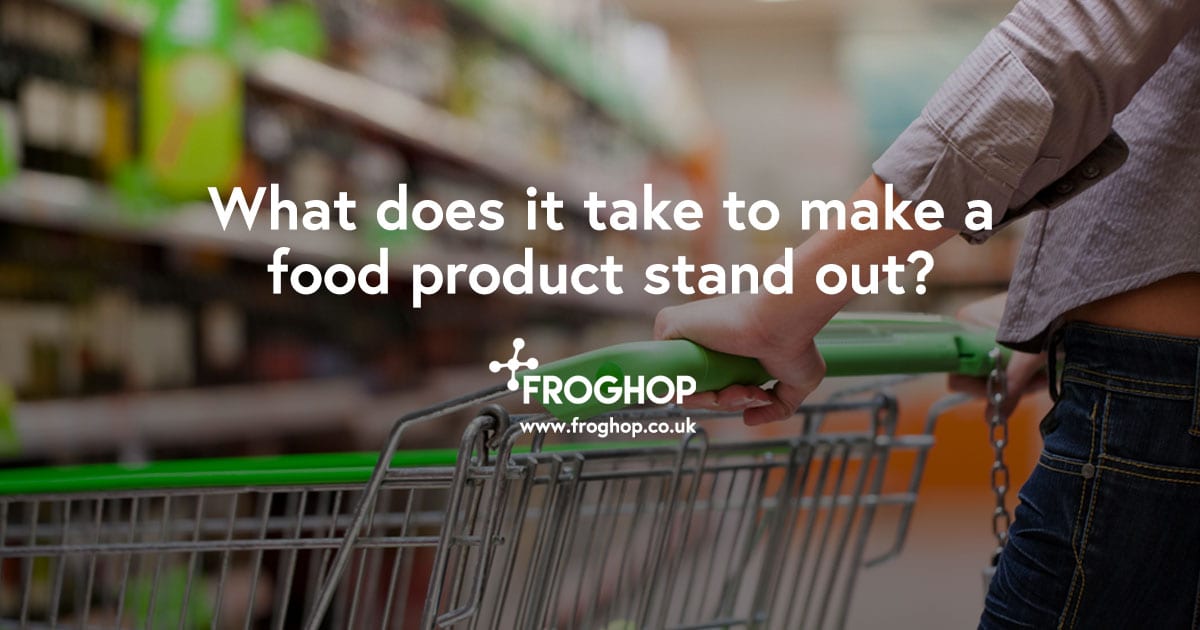While Froghop has been around for five years, I’ve been developing food and drink products for over twenty (Mel told the Food Tech Matters blog recently).
Over those two decades, I’ve been privileged to work with many passionate producers, food technicians, suppliers and consumers and learned so much about what it takes to make a food product stand out, get it off the ground and into the hands of consumers.
A good time to launch a new product
First of all, despite it being a very busy, crowded market place, it’s actually a great time to launch a food product. It’s widely acknowledged that independents and start-ups are driving the majority of innovation in the market. They’re generally less locked-into existing methods and processes. They’re free to experiment and launch new products, even create new categories, try new techniques and embrace alternative ingredients. However, we’re also seeing an increasing number of established food producers, looking to take a fresh look at their ingredients, claims and approach.
It’s undeniable that there’s a lot of competition, so you need to stand out. But how do you do go about it?
Begin with your USP
The key is to start with a crystal-clear idea of who your product is for and what its USP is. Everything hinges on this. Start by asking yourself:
- What are you making?
- Why this particular product?
- Who is it aimed at?
- What are they buying it for?
- Why should they buy it over competing or alternative products?
Armed with this information, you’ll be able to stay focused on your points of difference as you develop your product. It will also make your marketing that much more targeted when the time comes. Being clear about your objectives means you can also successfully engage with the experts, manufacturers and suppliers that can help you with specific parts of the process – the key job of a producer, in my opinion. The clearer you are about your needs, the better they will be able to advise and recommend.
Your goal is to emerge from the ideation, development and production process with an effective, tasty and innovative product.
Follow a tried-and-tested process
My experience has shown me that while innovations change, the process for creating a robust product is broadly the same and shouldn’t be overlooked.
- Start with a brief, taken from your reflections early on, namely a clear idea of what you want the product to achieve: nutritional or other claims, target shelf-life, use of specific ingredients, flavour profile or specific consumer requirements.
- Create a “paper” prototype – prototyping and samples are crucial, but it begins on paper with options about how to address the brief, based on how ingredients work together. Engaging with partners who can assist you with this is vital, so you can work out how your product will deliver the claims and benefits you need and how it will balance those with factors like taste, shelf-life and nutrition. This helps to hone the options available.
- Work up samples in the development kitchen to test.
- When you know how your product is shaping up, it’s time to source the right ingredients and product packaging. At Froghop, we advise on ingredient sourcing to meet producers’ quality, cost and scale requirements – from kitchen-based start-up activities to factory production. Finding the right packaging for your product can maximise shelf life and consumer handling (and cooking if appropriate).
- Test for safety and stability.Work with a lab team who can advise on product safety through ingredient choice and microbiological criteria and test for product stability. This also offers the opportunity to improve your product through formulation and processing modifications.
- Find the right manufacturer.The producer-manufacturer relationship is crucial, so you’ll need to take the time to find and quiz what will be a key business partner. For this, you’ll need to set out your expectations and create a robust manufacturing plan, including outlining costs and checking the capacity for when you need to scale-up. Making the wrong compromises at the manufacturing stage can significantly damage your product. (Check out our guide to finding a manufacturer.)
- Document your product – from manufacturing specification to labelling, technical product presentation and HACCP. It can be a tricky area to navigate but everything must be squared off to meet legislative requirements. You wouldn’t want to fall at this important hurdle and end up tied up in lots of red tape, delaying your launch. (We’ve also written about food labelling and making food claims and even have a handy food labelling checklist.)
- Target your marketing. You’ve established your USP, and you know your consumer. Now you need to solidify this into your marketing message. Give your customers clarity about what you’re offering. Outliningevery single benefit may seem like a good idea, but too many can mean you dilute your message. Instead, pick one or two main points. if you’ve done your homework, those points will be the ones your consumers want the most. Simple messages stand out.
Expand your product range
To give yourself a framework to quickly start considering your next product(s) it pays to take a structured approach and consider your objectives. Having followed a process and ensuring you have a clear vision means that extending your range is a smoother process. Creating a plan for delivering additional flavour variants or related products will give you, your retailers and/or your potential investors a clear idea about your business’ potential.
Find the right partner
I’ve touched on engaging with the team you’ll need along the way such as lab technicians and manufacturers. You might also need specialist ingredients suppliers, flavour specialists or marketing experts, to name a few. You can find them yourself or you can work with a partner, like Froghop – of course – who can guide you along the way and help bring everything together.
Our clients tell us that the process works best when the producer can keep their eyes firmly on what will make the product stand out, owning the vision. In my experience, producers want us to explain our rationales and recommendations, but they don’t want to get ‘bogged-down’ in the details. Sometimes compromises have to be made but, with the right advice, they can be the right ones and result in a fantastic product that rises far above the crowd.
This article originally appeared on foodtechmatters.com

